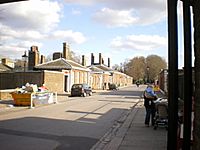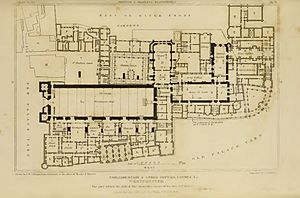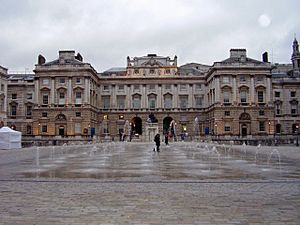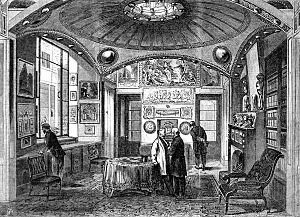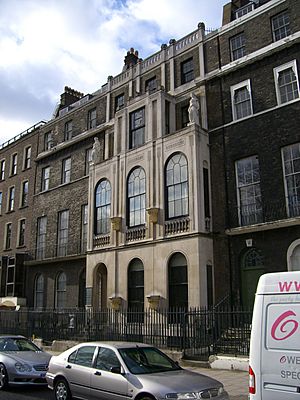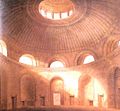John Soane facts for kids
Quick facts for kids
John Soane
|
|
|---|---|

Portrait painted by Thomas Lawrence
|
|
| Born |
John Soan
10 September 1753 Goring-on-Thames, Oxfordshire, England
|
| Died | 20 January 1837 (aged 83) 13 Lincoln's Inn Fields, London, England
|
| Occupation | Architect |
| Buildings |
|
Sir John Soane (born John Soan; 10 September 1753 – 20 January 1837) was a famous English architect. He specialized in the Neo-Classical style, which means he designed buildings inspired by ancient Greek and Roman styles.
John Soane started from humble beginnings. He was the son of a bricklayer. But he worked hard and became one of the most important architects of his time. He became a professor of architecture at the Royal Academy of Arts and an official architect for the government. He was even knighted in 1831, becoming "Sir John Soane."
His most famous work was the Bank of England building in London. Although much of his work there has been changed, it greatly influenced how commercial buildings were designed. He also designed the Dulwich Picture Gallery. This building, with its special skylights, changed how art galleries and museums were planned.
Today, his biggest legacy is the museum in Lincoln's Inn Fields, London. This was his home and office, and he designed it to show off his amazing collection of art and ancient objects. People describe the museum as one of the most complex and clever interiors ever created.
Contents
- Early Life and Training as an Architect
- The Grand Tour: Learning from Ancient Buildings
- Starting His Architectural Career
- Architect for the Bank of England
- Other Important Buildings and Roles
- Soane's Role at the Royal Academy
- Soane's Amazing Library
- Sir John Soane's Museum: A Unique Home and Collection
- Awards and Recognition
- Personal Life and Family
- Soane's Interests and Friends
- Death and Legacy
- Selected Architectural Works
- See also
Early Life and Training as an Architect

John Soane was born in Goring-on-Thames, England, on 10 September 1753. His father was a builder. When John was 14, his father passed away. John added the 'e' to his last name in 1784 when he got married.
After his father's death, Soane moved to Chertsey to live with his older brother, William. William helped John get a start in architecture. At 15, John began training with George Dance the Younger, a well-known architect. Dance was a founder of the Royal Academy of Arts, and he encouraged Soane to study there for free.
Soane was a talented student. In 1772, he won the Academy's silver medal for a drawing of the Banqueting House, Whitehall. In 1776, he won the gold medal for his design of a "Triumphal Bridge." These awards helped him get a special scholarship to travel and study in Europe.
The Grand Tour: Learning from Ancient Buildings
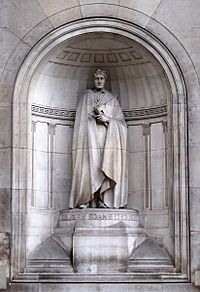
In 1778, Soane began his "Grand Tour," a long trip through Europe to study famous buildings. His main goal was Rome, Italy. He wrote home, "my attention is entirely taken up in the seeing and examining the numerous and priceless remains of Antiquity."
In Rome, he worked with another architect, Thomas Hardwick, to draw and measure ancient Roman buildings like the Colosseum and Hadrian's Villa. He also visited Naples and Pompeii, where he saw the ruins of the ancient city.
One of the most important parts of his trip was visiting the Greek temples at Paestum. He was very impressed by their design. He also traveled to Sicily, where he saw the strange and wonderful Villa Palagonia. The Hall of Mirrors there later inspired him when he designed his own home in London.
Soane continued his studies in places like Florence and Venice, looking at buildings by famous architects like Andrea Palladio. He learned a lot about classical architecture during this trip.
Starting His Architectural Career
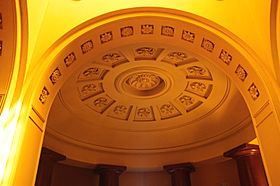
Soane returned to England in 1780. He was in debt from his travels, and it was hard to find work at first. He got some small jobs, like helping with repairs to Newgate Prison. He also redecorated Petersham Lodge for his friend Thomas Pitt.
Slowly, his career began to take off. In 1783, he got his first big job: designing a new country house called Letton Hall in Norfolk. This led to more work on country homes in the area.
Architect for the Bank of England
A major turning point came in 1788 when Soane became the architect for the Bank of England. He worked there for 45 years, almost completely rebuilding and expanding the bank. This was a huge project.
Soane designed the bank's main halls to be fireproof, using brick vaults and iron-framed windows. He created the famous "Tivoli Corner," inspired by an ancient Roman temple he admired.
His work at the Bank of England was considered a masterpiece. However, much of it was later torn down in the 20th century, which many people consider a great loss.
Other Important Buildings and Roles
Soane became a member of the Architects' Club in 1791, a group of leading architects in London. In 1807, he became the clerk of works for the Royal Hospital Chelsea, where he designed new buildings like an infirmary and a guard-house.
He also designed a new gallery for Freemasons' Hall, London in 1821. As an official architect for the government's Office of Works from 1813 to 1832, he advised on building new churches. He designed three classical-style churches: St Peter's Church, Walworth, Holy Trinity Church, Marylebone, and St John on Bethnal Green.
Soane designed several public buildings in London, including the National Debt Redemption Office and offices in Whitehall. He also worked in Ireland, designing the Royal Belfast Academical Institution.
Designing Country Homes

Soane designed and remodeled many country homes for wealthy families. These included Wimpole Hall, Tyringham Hall, and Aynhoe Park. He also designed new rooms and interiors for places like Port Eliot and the Gothic Library at Stowe House.
He even designed the dining rooms for the Prime Minister's home at 10 Downing Street and the Chancellor of the Exchequer's home at 11 Downing Street.
Dulwich Picture Gallery: A New Kind of Art Museum

In 1811, Soane was chosen to design the Dulwich Picture Gallery. This was the first building in Britain made specifically to be a public art museum. It was built to house a collection of paintings.
The building also includes a special mausoleum (a tomb) for the art collectors who left their paintings to the gallery. The main art galleries are lit by unique skylights, which was a new idea at the time.
Law Courts and Parliament Buildings
As a government architect, Soane designed the New Law Courts at Westminster Hall. He had to redesign the building in a Gothic style after some criticism, even though he usually designed classical buildings.
He also made changes to the House of Lords at the Palace of Westminster, adding new rooms and a grand staircase. Sadly, most of his work there was destroyed in a fire in 1834.
Designing a Royal Palace
Soane also created designs for a new Royal Palace in London. These designs were triangular in shape with grand entrances. It seems this was a design exercise for him, not an actual commission.
Soane's Role at the Royal Academy
The Royal Academy was very important to Soane's career. He studied there, and they paid for his Grand Tour. In 1802, he became a full Royal Academician, one of only 40 at a time.
In 1806, Soane became the Professor of Architecture at the Royal Academy. He gave many lectures, which were illustrated with over a thousand drawings by his students. These lectures covered everything from the history of architecture to how to design rooms and buildings.
Soane's Amazing Library
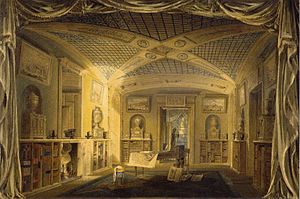

Over his career, Soane built up a huge library of nearly 8,000 books. This collection is still kept in his former home, now the Sir John Soane's Museum.
His library had books on many subjects, including Greek and Roman classics, poetry, history, and philosophy. Of course, it had many architectural books, which were very important for his lectures. He owned different editions of famous architectural texts like Vitruvius's De architectura.
Soane also collected rare manuscripts, including a 13th-century Bible and 15th-century copies of Josephus's works. He even owned a copy of William Shakespeare's First Folio, a very rare and important book.
Sir John Soane's Museum: A Unique Home and Collection
In 1792, Soane bought a house at 12 Lincoln's Inn Fields in London. Later, he bought the house next door, number 13. He redesigned and expanded these houses to be his home, office, and a place to display his growing collection.
He collected many ancient objects, including pieces worthy of the British Museum. One of his most famous acquisitions was the Sarcophagus of Seti I in 1824. When it arrived, Soane held a huge three-day party with hundreds of guests to celebrate.
His collection includes Greek and Roman bronzes, vases, busts, and fragments of sculpture. He also had medieval objects like stained glass, and even Chinese ceramics and Peruvian pottery.
Art and Drawings
Soane's art collection includes paintings by famous artists like Canaletto and William Hogarth. He owned Hogarth's famous series A Rake's Progress and Humours of an Election. He also had paintings by his friend J. M. W. Turner and a portrait of himself by Thomas Lawrence.
The museum also holds over 30,000 architectural drawings. Many of these are Soane's own designs, but there are also drawings by other famous architects like Christopher Wren and Robert Adam. He also collected 252 architectural models, including 118 of his own buildings.
In 1833, Soane arranged for a special law to be passed. This law made sure that his house and collection would be given to the British Nation after his death. It would become a museum of architecture, which is now the Sir John Soane's Museum.
Awards and Recognition
Soane received many awards and honors throughout his life:
- He won the Royal Academy's Silver Medal in 1772 and the Gold Medal in 1776.
- He received the Royal Academy's traveling scholarship in 1777.
- He was appointed architect to the Bank of England in 1788.
- He became a Royal Academician in 1802.
- He was made Professor of Architecture at the Royal Academy in 1806.
- He became a Justice of the Peace for Middlesex in 1810.
- He was elected a Fellow of the Royal Society in 1821.
- He received a knighthood from King William IV in 1831.
- In 1835, he was given a Gold Medal by the 'Architects of England' for his contributions to architecture.
Personal Life and Family
Marriage and Children
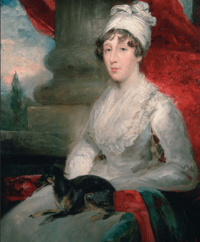
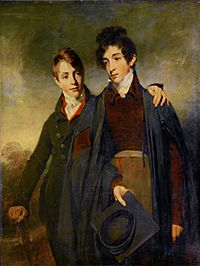
In 1784, John Soane married Elizabeth Smith, whom he called Eliza. She became his close friend and supporter. They had four sons: John (born 1786), George (born 1787, died young), George (born 1789), and Henry (born 1790, died young).
Soane's Homes
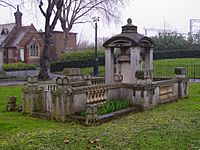
After inheriting some money, Soane bought Pitzhanger Manor in Ealing in 1800. He rebuilt it to his own design, hoping it would inspire his son George to become an architect. However, his sons were not interested in architecture.
He later bought 12 and 13 Lincoln's Inn Fields, which he rebuilt and connected. In 1823, he bought 14 Lincoln's Inn Fields and added his Picture Room there. These houses became the famous museum.
Family Challenges
Soane faced difficulties with his sons. They were not interested in architecture, which disappointed him. His son George often caused trouble and tried to get money from his father unfairly.
In 1815, an article criticizing Soane was published, and it turned out George had written it. This deeply upset Soane's wife, Eliza, who was already unwell. She passed away in November 1815. Soane was heartbroken and wrote in his diary, "The burial of all that is dear to me in this world, and all I wished to live for!"
In 1816, Soane designed a special tomb for his wife in the churchyard of St Pancras Old Church. The tomb has symbols of eternity and regeneration, avoiding Christian symbols. This tomb's design later influenced the famous red telephone box. Soane's elder son, John, died in 1823 and was also buried in the family tomb.
Soane's Interests and Friends
Soane was a Freemason, joining in 1813. He became a Grand Officer, helping with the buildings of the Freemasons' Hall. He was also interested in the ideas of the Age of Enlightenment, reading works by thinkers like Voltaire.
He enjoyed traveling. In 1810, he and his wife took a 13-day tour of England and Wales, visiting many towns and historical sites. He also traveled to Paris several times, exploring its famous buildings and gardens.
Soane had many friends, including famous artists and architects. He was close with J. M. W. Turner, the painter, and owned some of his works. He also remained friends with his old teacher, George Dance the Younger. Despite being rivals, he got along well with fellow architect John Nash.
Death and Legacy
Sir John Soane died on 20 January 1837, at his home in Lincoln's Inn Fields. He was buried in the family tomb with his wife and elder son.
Before his death, he made sure his house and collection would become a museum for everyone to enjoy. This museum, Sir John Soane's Museum, is his lasting gift to the nation. It allows visitors to step into the world of a brilliant architect and see his unique vision and vast collection.
Selected Architectural Works
- Aynhoe Park, Aynho, Northamptonshire (1799–1804); remodelled the interior
- Bank of England, London (1788–1833)
- Chillington Hall, Staffordshire (1785–89); remodelled.
- Cricket House, Somerset (1794 and 1801–04)
- Dulwich Picture Gallery, London (1811–14)
- Freemasons' Hall, London (1828); demolished 1864.
- Holy Trinity Church, Marylebone (1826–27)
- Honing Hall, Norfolk
- Kelshall Rectory, Hertfordshire (1788)
- Moggerhanger House, Bedfordshire (1809–11)
- Pell Wall Hall, Market Drayton, Shropshire (1822–28)
- Piercefield House, Monmouthshire, Wales (1785–83)
- Pitzhanger Manor, Ealing (1800–03)
- Royal Belfast Academical Institution (1809–14)
- Royal Hospital Chelsea (1809–17)
- Ryston Hall, Norfolk (1780), alterations
- St. John's Church, Bethnal Green (1826–28)
- St Peter's Church, Walworth (1823–24)
- Soane Museum, Lincoln's Inn Fields, a museum (originally Soane's home); various remodellings from 1792 to 1824
- South Hill Park, Berkshire (1801)
- Tyringham Hall, Newport Pagnell, Buckinghamshire (1793–1800)
- Wimpole Hall, Arrington, Royston, Cambridgeshire (1791–93)
- Wokefield Park, Berkshire (1788–89)
- Wotton House, Buckinghamshire (1821–22)
See also
 In Spanish: John Soane para niños
In Spanish: John Soane para niños



